Overview
The article focuses on the techniques and tips for enhancing core strength through effective workouts, emphasizing the importance of core exercises for overall health and athletic performance. It supports this by detailing various essential exercises, such as planks and Russian twists, while also highlighting the benefits of proper form and the role of core strength in injury prevention and daily activities, thereby underlining the necessity of incorporating core workouts into fitness regimens.
Introduction
In a world where physical fitness is paramount, the significance of core workouts often goes underestimated. A strong core is not just essential for athletes; it serves as the foundation for everyday movements, enhancing posture, stability, and overall performance. From lifting heavy objects to maintaining balance during daily activities, a well-conditioned core can drastically reduce the risk of injuries and alleviate chronic pain.
As research continues to unveil the myriad benefits of core training, individuals are encouraged to embrace a variety of exercises that target this pivotal muscle group. This article delves into the importance of core workouts, essential exercises, proper techniques, and common misconceptions, empowering readers to enhance their fitness regimen and improve their quality of life.
Understanding the Importance of Core Workouts
Core wod workouts are essential for sustaining proper posture, enhancing balance, and maximizing athletic performance. A strong foundation not only supports the spine but also offers essential stability, which is crucial for performing a wide range of physical activities—from weightlifting to everyday movements like bending and twisting. Research has indicated that foundational training has a significantly large effect on physical strength, specifically endurance and balance.
Additionally, a well-conditioned core wod can significantly lower the risk of injuries and alleviate lower back pain, making it an integral component of any fitness regimen. According to the Mayo Clinic, engaging in core WOD activities is essential for strengthening central muscles and overall fitness. As Sarah Walls, a personal trainer and owner of Strength & Performance Training, Inc., observes,
You get a lot of these fundamental exercises where there’s no spinal movement — or very little — depending on what you’re doing.
Moreover, a 2018 study emphasized the connection between trunk stability and injury prevention, indicating that individuals with a history of lower extremity injuries should include trunk strengthening in their training. The findings indicated that those who participated in core wod workouts experienced enhanced stability, which directly contributed to a reduced risk of injury. By prioritizing essential strength, individuals not only promote their physical health but also foster improved mental well-being, as regular exercise has been associated with reduced stress levels and increased productivity in the workplace.
Furthermore, the focus on essential workouts can result in improved pain management, as strengthening these tissues plays a vital role in relieving lower back discomfort and enhancing overall movement efficiency.
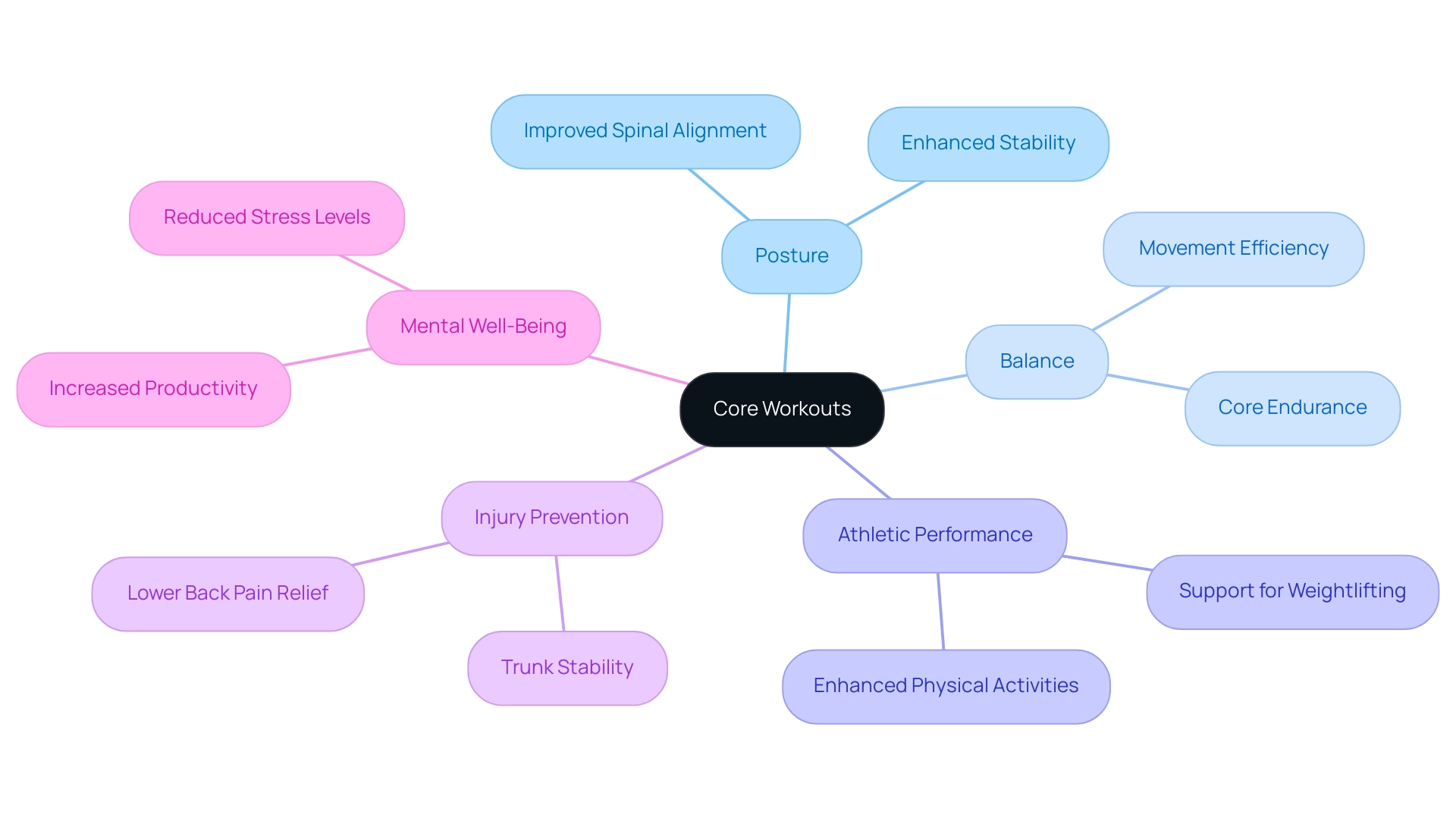
Essential Core Exercises for Strength and Stability
- Plank: Recognized as a cornerstone of abdominal training, the plank effectively engages multiple abdominal muscles, including the transverse abdominis (Tra), internal obliques (IO), and lumbar multifidus (LM). To perform this exercise, position your body in a straight line from head to heels, supporting yourself on your forearms and toes. Aim to maintain this position for 30 seconds to 1 minute. Research suggests that executing the front plank on a Swiss ball with hip extension significantly boosts activation levels for the multifidus, demonstrating its effectiveness in developing abdominal strength. However, it is important to note that the level of evidence from the included studies is mainly moderate, suggesting the need for more high-quality research to reduce bias and draw solid conclusions about central body activity (J.M.M.).
- Russian Twists: This dynamic movement focuses on the oblique areas while also involving the entire torso. Begin seated on the floor with your knees bent and lean back slightly while maintaining a straight back. Rotate your torso to one side, then the other, while holding a weight or medicine ball. Aim for 15-20 repetitions on each side. Anecdotal success stories highlight how incorporating Russian twists has led to improved core wod strength and stability among practitioners. Notably, statistical analyses have shown significant differences in muscle thickness based on the type of activity, with Russian twists ranking high for activating the obliques.
- Dead Bug: Excellent for developing coordination and stability, the Dead Bug movement requires you to lie on your back with arms extended toward the ceiling and knees bent at a 90-degree angle. Slowly lower one arm and the opposite leg toward the floor, then return to the starting position. Repeat this movement on the other side for 10-15 repetitions. This activity is especially effective for engaging the abdomen without stressing the lower back, making it appropriate for all fitness levels. The statistical techniques used in related research back the efficiency of this activity for improving muscle thickness in central muscles.
- Bird-Dog: This activity enhances balance and stability while also involving the abdominal muscles. Start from a tabletop position on your hands and knees, then extend one arm forward and the opposite leg back, holding the position for a few seconds. Switch sides and repeat for 10-15 reps on each side. The Bird-Dog is commended by fitness instructors for its capacity to fortify the midsection while also improving overall body coordination.
Incorporating these essential core wod exercises into your routine can significantly enhance strength and stability, laying a solid foundation for more advanced movements.
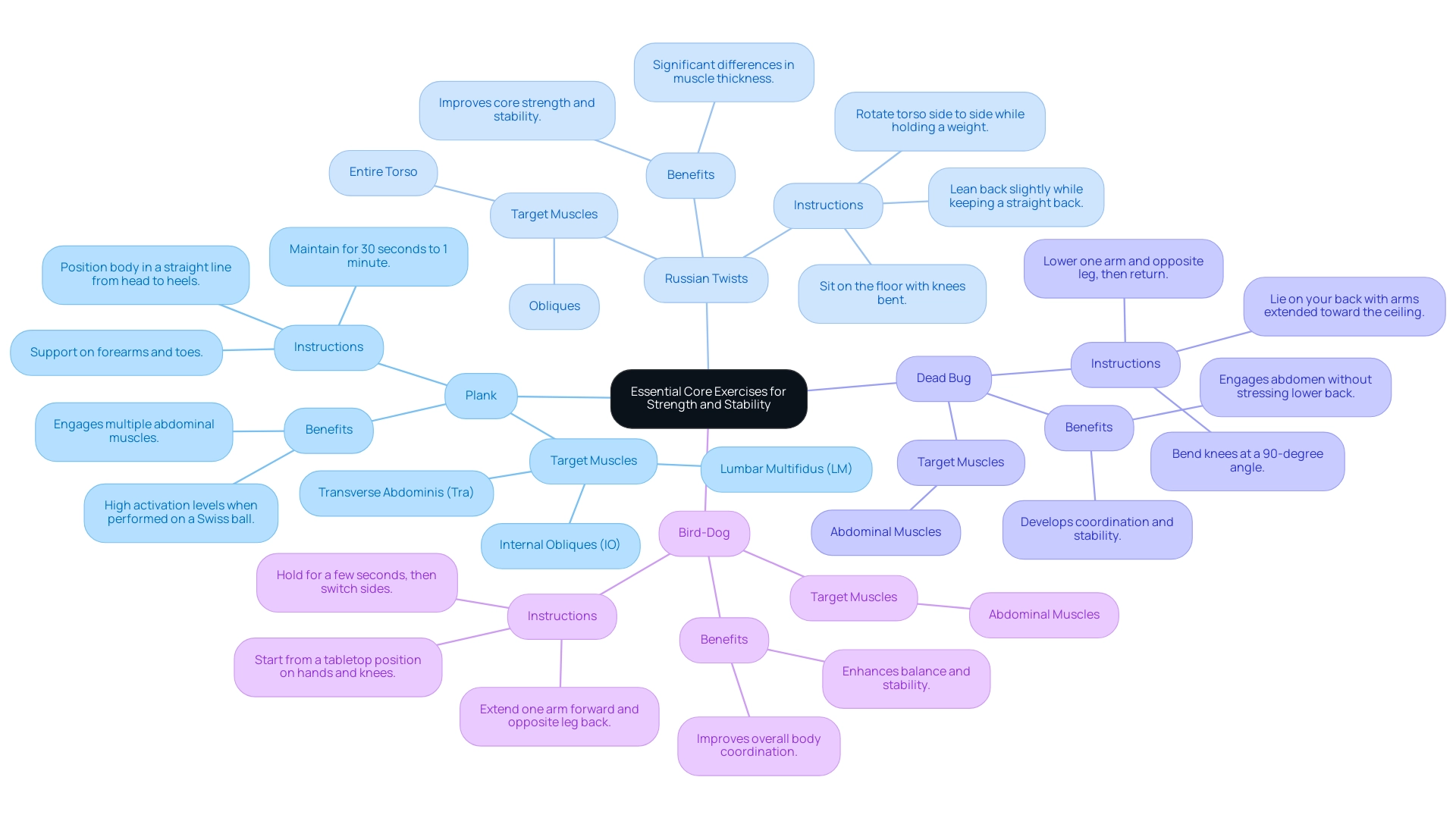
Mastering Techniques: Proper Form for Core Exercises
- Plank: To execute a plank effectively, position your elbows directly beneath your shoulders and actively engage your abdominal muscles. It's crucial to avoid sagging your hips or lifting your buttocks too high, as these deviations can lead to unnecessary strain on your lower back. According to physical therapists, maintaining a straight line from head to heels is essential for optimal trunk activation and injury prevention. Research indicates that fundamental training has a significant effect on performance metrics, with an effect size of ES = 0.84 (p = 0.01) for horizontal jump performance, underscoring the importance of these exercises.
- Russian Twists: When performing Russian twists, maintaining a straight back is vital. Rotating too far can place undue stress on your back. Concentrate on controlled, intentional movements, making sure that your center is engaged during the activity. Proper form statistics indicate that maintaining alignment during this activity significantly reduces the risk of injury. Furthermore, physical therapists emphasize that incorrect techniques can negate the benefits of foundational workouts.
- Dead Bug: The dead bug activity requires careful attention to your lower back. Ensure that it remains pressed into the floor as you lower your limbs; arching can lead to discomfort and potential injury. Involving your midsection throughout the movement not only stabilizes your spine but also maximizes muscle activation. Insights from case studies, such as Hlaing et al.’s evaluation of CSE versus strengthening routines, show that proper form leads to better proprioception and balance, which are essential for effective training.
- Bird-Dog: In the bird-dog exercise, the goal is to extend your limbs while preserving balance. Your back should stay flat during the movement, which is essential for effective muscle engagement. Breathing steadily during each repetition will help maintain stability, contributing to better overall performance. Research shows that exercises performed on unstable surfaces, such as a whole-body wobble board, can significantly increase EMG activity, enhancing the effectiveness of your workout.
In addressing these exercises, it’s important to acknowledge common mistakes. Many individuals tend to overlook proper form, which can hinder progress and lead to injuries. For instance, a study concluded that tools such as the ab roller are no more effective than traditional crunches, while the ab rocker is up to 80% less effective. By concentrating on proper techniques and grasping the consequences of incorrect form, you can significantly improve the effectiveness of your workouts.
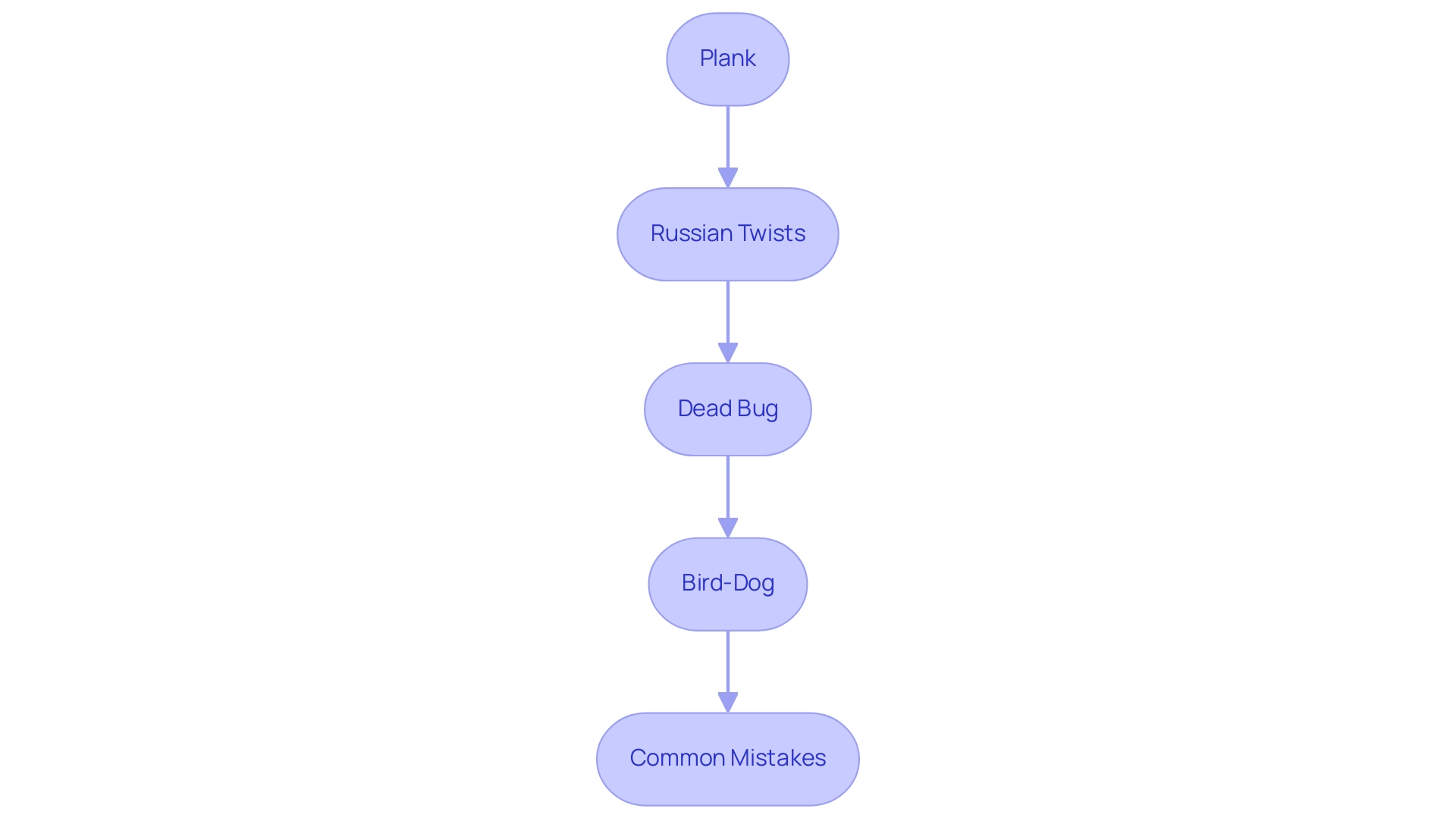
How Core Strength Enhances Performance in Daily Life
A strong foundation is vital for executing daily tasks with efficiency and comfort. Activities such as lifting heavy objects, maintaining proper posture while seated, and even engaging in play with children all depend on a stable foundational support. Improved strength in the center translates to better balance, significantly reducing the risk of falls and injuries, particularly as we grow older.
Studies suggest that foundational exercise produces a medium effect size in agility (SMD = -0.54; 95% CI: -1.23–0.15), highlighting its significance for physical performance. However, it's important to note that the methodological quality of the reviewed studies was low, indicating a need for more rigorously designed randomized controlled trials to better understand these effects. Moreover, Lee & McGill emphasize that the results found that isometric and dynamic training increased impact force in almost all tests.
A well-developed center that incorporates core wod not only aids in daily life activities but also boosts athletic performance—enabling individuals to run faster, jump higher, and participate more effectively in sports and recreational pursuits. Including essential strength routines, like bird dogs and bicycle crunches, in a core wod can greatly strengthen the center and improve overall fitness. These core wod exercises have been shown to improve stability and lead to long-term benefits in both everyday life and athletic endeavors, as highlighted in the case study 'Core Strength Exercises to Add to Your Workout routine.
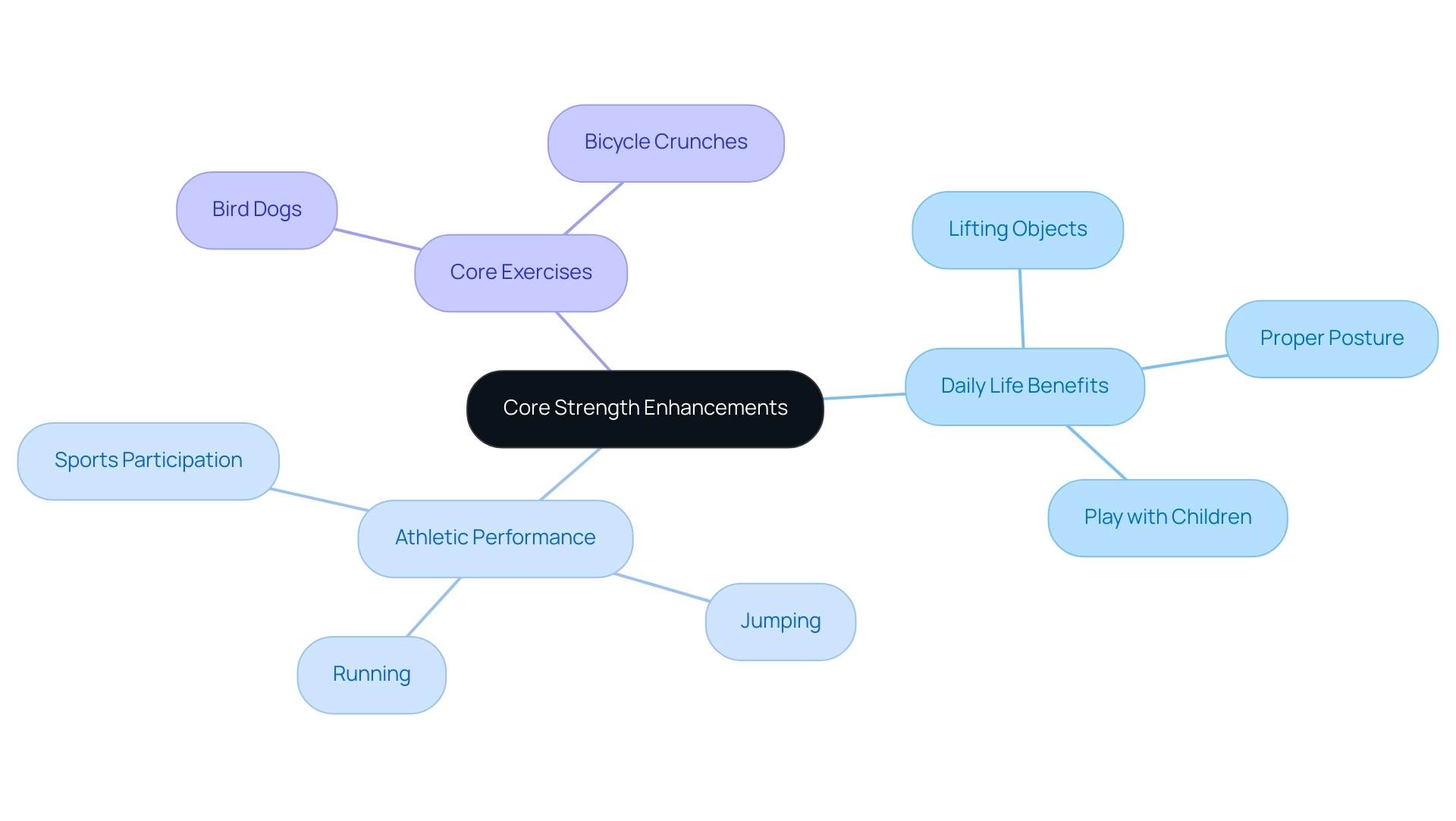
Incorporating Core Workouts into Your Fitness Regimen
To effectively incorporate fundamental workouts into your fitness routine, consider the following strategies that have demonstrated success in various exercise environments:
- Prioritize Essential Workouts: Schedule specific days for abdominal training, treating these sessions as non-negotiable appointments in your calendar. This structured approach emphasizes the significance of recovery time for primary muscles, which need rest after intense workouts, akin to other muscle groups. Research indicates that 14 studies conducted during competition or rest periods highlight the effectiveness of structured central training.
- Combine with Other Exercises: Enhance your training efficiency by integrating core wod exercises into your regular workouts. For instance, performing planks between sets of weightlifting or adding abdominal circuits to your cardio sessions can maximize both strength and endurance.
- Utilize Short, Effective Sessions: Even brief central workouts, lasting just 10-15 minutes, can yield significant benefits. The key is consistency—aim to engage your center regularly rather than focusing solely on workout duration.
- Stay Creative: Keep your routine fresh and engaging by varying activities. Incorporate diverse workouts such as yoga or Pilates to challenge different muscle groups, ensuring your training remains stimulating and effective. As Rick Richey aptly states,
Just because stabilization exercises are the first part of a progressive program, that doesn’t mean they’re easy. They can be very difficult to perform and even more difficult to do well.
This emphasizes the need for a thoughtful approach to fundamental training.
- Monitor Progress: Implement a tracking system for your core WOD workouts. This can provide insights into your performance and motivate continuous improvement through core wod.
- Educate and Encourage: Share knowledge about fundamental training with colleagues and promote participation in group sessions. This not only promotes a supportive atmosphere but also highlights the collective advantages of strong fundamental muscles. Furthermore, insights from the case study titled 'Limitations of Core Training Studies' reveal the challenges in blinding participants and the need for rigorous research designs, which further underscores the importance of a structured approach to foundational training.
By employing these strategies, you can foster a culture of fitness that prioritizes central strength, ultimately contributing to overall health and performance.
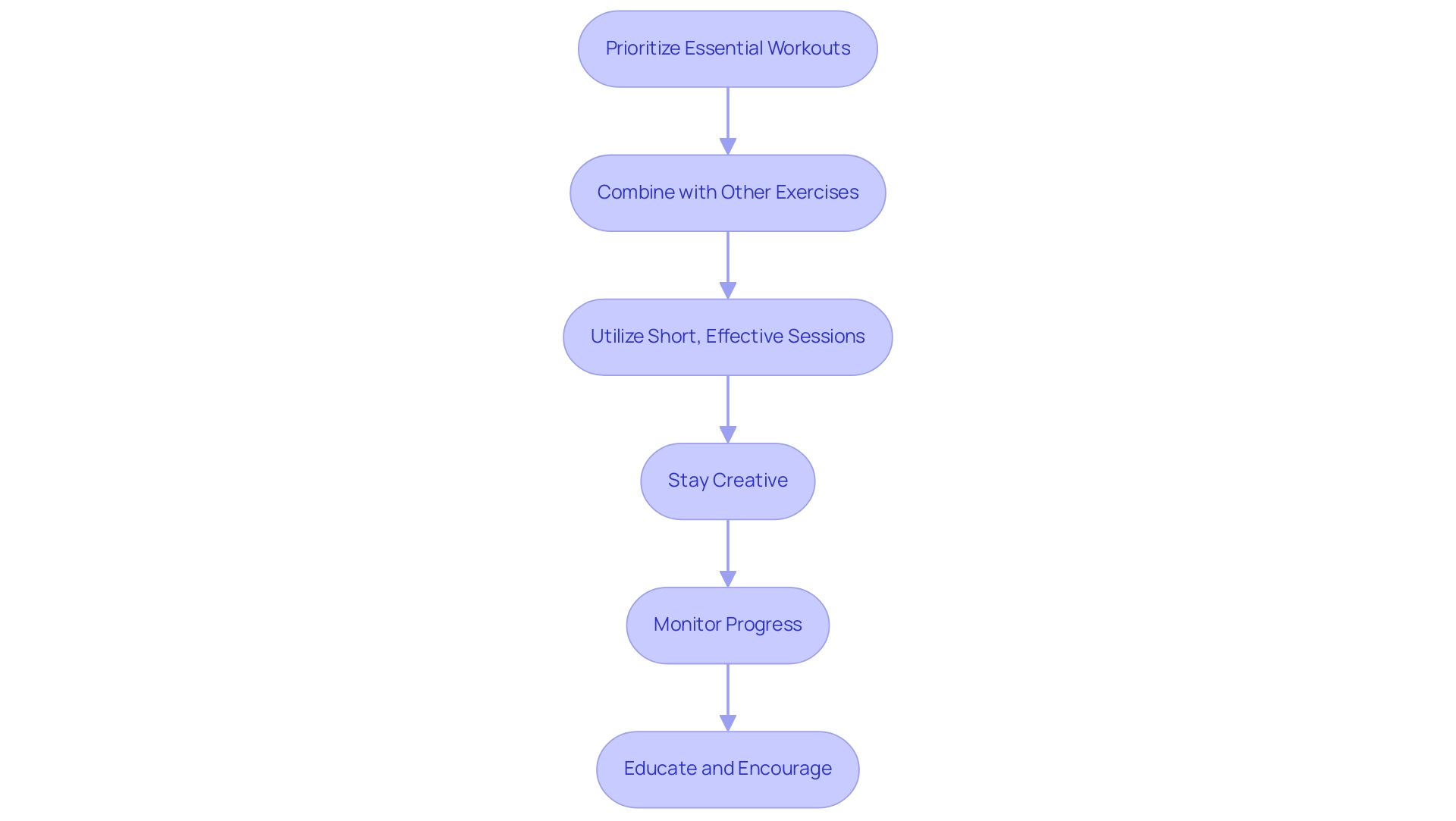
Debunking Myths: What You Need to Know About Core Training
-
Myth: Crunches are the only way to strengthen your midsection: Although crunches are widely recognized, they do not encompass the full potential of strengthening exercises. Research demonstrates that a variety of movements engage the core wod muscles more comprehensively, enhancing stability and functionality.
-
Myth: Core WOD is only for athletes: Core strength is essential for everyone, regardless of fitness levels. It plays a crucial role in daily activities and injury prevention, underscoring its universal importance. Stuart McGill, a Ph.D. and professor of spine biomechanics, emphasizes,
Flexion-intolerant backs are very common. Eliminating spinal flexion exercises, particularly in the morning, has proven very effective.
This statement emphasizes the need for flexible training strategies in core wod. Furthermore, pacing activities and requesting assistance with heavy lifting can greatly decrease the likelihood of pain flare-ups, highlighting the necessity for a holistic approach to strength. -
Myth: You can spot-reduce fat by performing abdominal workouts: While abdominal routines effectively enhance the strength of the body, they do not specifically aim at reducing belly fat. A comprehensive fitness regimen, combined with a balanced diet, is vital for achieving overall fat loss. The notion of spot reduction is a common misconception that can mislead individuals in their fitness journeys.
-
Myth: Central workouts only benefit your abs: The central region comprises not only the abdominal muscles but also the back, hips, and pelvic floor, all contributing to overall central strength. Strengthening these areas enhances stability and functionality in various movements, thereby supporting better performance in core wod and daily activities. Research suggests that low-load stabilization exercises may be somewhat more effective in alleviating pain in the short term, demonstrating the diverse advantages of a comprehensive strength program. Furthermore, a study by Luomajoki et al. (2007) highlighted the reliability of movement control tests for patients with low back pain, suggesting that observed movement flaws may be effects rather than causes of pain, reinforcing the importance of a comprehensive approach to core wod training.
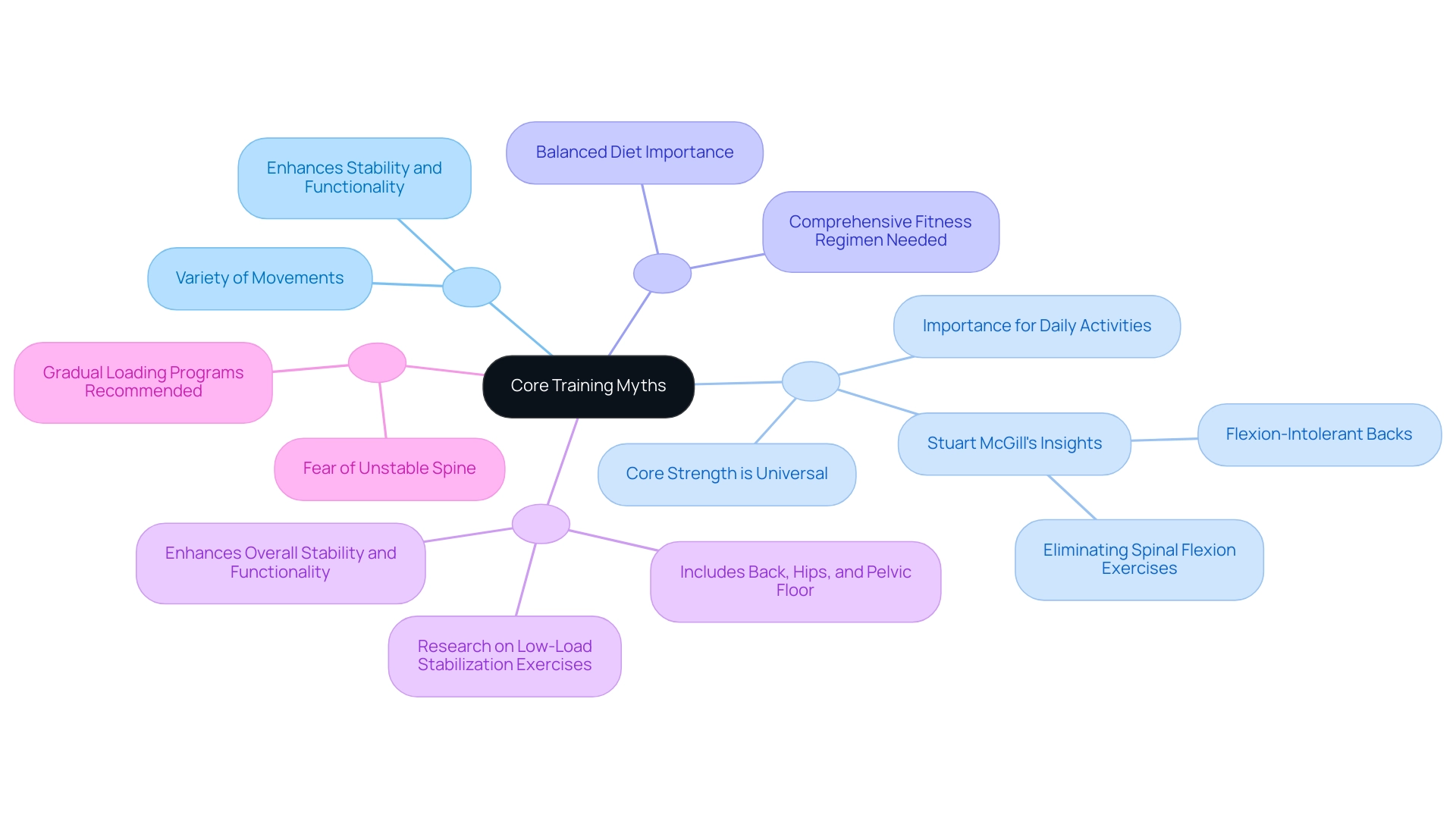
Conclusion
A strong core is fundamental not just for athletes but for everyone seeking to enhance their overall fitness and well-being. This article has highlighted the essential role of core workouts in promoting better posture, stability, and injury prevention. By engaging in targeted exercises such as:
- Planks
- Russian twists
- The dead bug
individuals can build a robust core that supports daily activities and athletic performance alike.
Proper technique is vital to maximize the benefits of core training while minimizing the risk of injury. Emphasizing correct form in exercises ensures effective muscle engagement and enhances overall performance. Additionally, incorporating core workouts into a regular fitness regimen—through structured training days, integration with other exercises, and consistent practice—can yield significant improvements in strength and stability.
Moreover, debunking common myths surrounding core training reveals that it is a vital component for all fitness levels, not just athletes. Understanding the multifaceted nature of the core and recognizing that it encompasses more than just abdominal muscles can lead to a more comprehensive and effective approach to fitness.
Ultimately, prioritizing core workouts not only enhances physical capabilities but also contributes to better mental health and pain management. Embracing a variety of exercises and techniques can transform fitness routines, leading to a stronger, more resilient body capable of tackling both everyday challenges and athletic endeavors.
Frequently Asked Questions
What are core WOD workouts, and why are they important?
Core WOD workouts are essential for sustaining proper posture, enhancing balance, and maximizing athletic performance. They provide a strong foundation that supports the spine and offers stability for various physical activities, reducing the risk of injuries and alleviating lower back pain.
How do core workouts contribute to injury prevention?
Core workouts enhance trunk stability, which is crucial for injury prevention. Research indicates that individuals with a history of lower extremity injuries should include trunk strengthening in their training to reduce the risk of further injuries.
What are the mental health benefits of engaging in core workouts?
Regular core workouts are associated with improved mental well-being, as they can reduce stress levels and increase productivity in the workplace.
What are some essential core exercises included in core WOD workouts?
Essential core exercises include: 1. Plank: Engages multiple abdominal muscles, performed by maintaining a straight line from head to heels for 30 seconds to 1 minute. 2. Russian Twists: Focuses on the obliques, performed seated with torso rotation while holding a weight, aiming for 15-20 repetitions on each side. 3. Dead Bug: Enhances coordination and stability, involving alternating arm and leg movements while lying on your back for 10-15 repetitions. 4. Bird-Dog: Improves balance and stability, performed from a tabletop position by extending opposite arm and leg for 10-15 repetitions on each side.
How do core workouts impact lower back pain?
Strengthening the core through specific exercises plays a vital role in relieving lower back discomfort and enhancing overall movement efficiency.
What does research say about the effectiveness of core workouts?
Research has shown that foundational training significantly improves physical strength, specifically endurance and balance, and highlights the importance of core workouts in enhancing muscle activation and stability.

